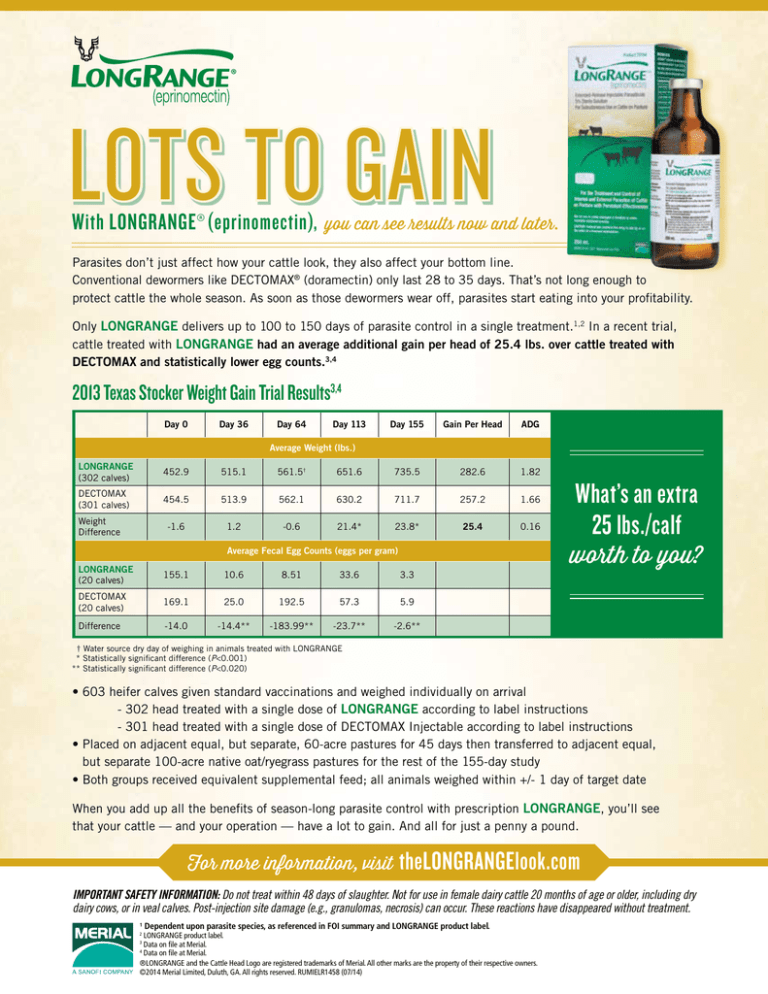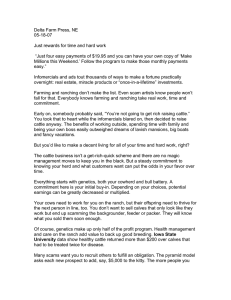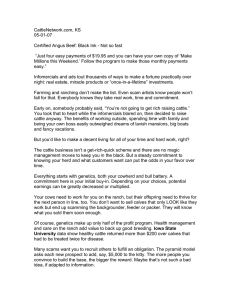
Lots to gain
With LONGRANGE ® (eprinomectin),
you can see results now and later.
Parasites don’t just affect how your cattle look, they also affect your bottom line.
Conventional dewormers like DECTOMAX® (doramectin) only last 28 to 35 days. That’s not long enough to
protect cattle the whole season. As soon as those dewormers wear off, parasites start eating into your profitability.
Only LONGRANGE delivers up to 100 to 150 days of parasite control in a single treatment.1,2 In a recent trial,
cattle treated with LONGRANGE had an average additional gain per head of 25.4 lbs. over cattle treated with
DECTOMAX and statistically lower egg counts.3,4
2013 Texas Stocker Weight Gain Trial Results3,4
Day 0
Day 36
Day 64
Day 113
Day 155
Gain Per Head
ADG
Average Weight (lbs.)
LONGRANGE
(302 calves)
452.9
515.1
561.5†
651.6
735.5
282.6
1.82
DECTOMAX
(301 calves)
454.5
513.9
562.1
630.2
711.7
257.2
1.66
-1.6
1.2
-0.6
21.4*
23.8*
25.4
0.16
Weight
Difference
Average Fecal Egg Counts (eggs per gram)
LONGRANGE
(20 calves)
155.1
10.6
8.51
33.6
3.3
DECTOMAX
(20 calves)
169.1
25.0
192.5
57.3
5.9
Difference
-14.0
-14.4**
-183.99**
-23.7**
-2.6**
What’s an extra
25 lbs./calf
worth to you?
† Water source dry day of weighing in animals treated with LONGRANGE
* Statistically significant difference (P<0.001)
** Statistically significant difference (P<0.020)
• 603 heifer calves given standard vaccinations and weighed individually on arrival
- 302 head treated with a single dose of LONGRANGE according to label instructions
- 301 head treated with a single dose of DECTOMAX Injectable according to label instructions
• Placed on adjacent equal, but separate, 60-acre pastures for 45 days then transferred to adjacent equal,
but separate 100-acre native oat/ryegrass pastures for the rest of the 155-day study
• Both groups received equivalent supplemental feed; all animals weighed within +/- 1 day of target date
When you add up all the benefits of season-long parasite control with prescription LONGRANGE, you’ll see
that your cattle — and your operation — have a lot to gain. And all for just a penny a pound.
For more information, visit
theLONGRANGElook.com
IMPORTANT SAFETY INFORMATION: Do not treat within 48 days of slaughter. Not for use in female dairy cattle 20 months of age or older, including dry
dairy cows, or in veal calves. Post-injection site damage (e.g., granulomas, necrosis) can occur. These reactions have disappeared without treatment.
1
Dependent upon parasite species, as referenced in FOI summary and LONGRANGE product label.
LONGRANGE product label.
Data on file at Merial.
4
Data on file at Merial.
®LONGRANGE and the Cattle Head Logo are registered trademarks of Merial. All other marks are the property of their respective owners.
©2014 Merial Limited, Duluth, GA. All rights reserved. RUMIELR1458 (07/14)
2
3
TM
Extended-Release Injectable Parasiticide
5% Sterile Solution
For the Treatment and Control of Internal and External
Parasites of Cattle on Pasture with Persistent Effectiveness
Not for use in female dairy cattle 20 months of age or older, including dry
dairy cows. Not for use in calves to be processed for veal.
Not for use in breeding bulls, or in calves less than 3 months of age.
Not for use in cattle managed in feedlots or under intensive rotational
grazing.
CAUTION: Federal law restricts this drug to use by or on the order of a
licensed veterinarian.
DESCRIPTION
LONGRANGE™ (eprinomectin) is a ready-to-use, sterile injectable preparation
containing eprinomectin, a member of the macrocyclic lactone class of
antiparasitics. Each mL of LONGRANGE contains 50 mg of eprinomectin in a
co-solvent system of N-methyl-2-pyrrolidone (30% v/v) and triacetin (qs), along
with 50 mg of poly-lactide-co-glycolic-acid 75:25 (PLGA), a polymer that allows
a slow release of eprinomectin from the formulation, thereby maintaining a
prolonged duration of product effectiveness. Butylated hydroxytoluene (0.2 mg/
mL) acts as an antioxidant in the formulation.
The chemical name of eprinomectin is 4”-deoxy-4”-epiacetylamino-avermectin
B1. It is a semi-synthetic member
of the avermectin family of
compounds consisting of a mixture
of two homologous components,
B1a and B1b, which differ by a single
methylene group at C26.
INDICATIONS FOR USE
LONGRANGE, when administered
at the recommended dose volume of 1 mL per 110 lb (50 kg) body weight, is
effective in the treatment and control of the following internal and external
parasites of cattle:
Gastrointestinal Roundworms
Lungworms
Bunostomum phlebotomum – Adults and L4 Dictyocaulus viviparus – Adults
Cooperia oncophora – Adults and L4
Cooperia punctata – Adults and L4
Cooperia surnabada – Adults and L4
Haemonchus placei – Adults
Grubs
Hypoderma bovis
Oesophagostomum radiatum – Adults
Ostertagia lyrata – Adults
Ostertagia ostertagi – Adults, L4, and
inhibited L4
Trichostrongylus axei – Adults and L4
Mites
Trichostrongylus colubriformis – Adults
Sarcoptes scabiei var. bovis
Persistent Activity
LONGRANGE has been proven to effectively protect cattle from reinfection with
the following parasites for the indicated amounts of time following treatment:
Parasites
Gastrointestinal Roundworms
Bunostomum phlebotomum
Cooperia oncophora
Cooperia punctata
Haemonchus placei
Oesophagostomum radiatum
Ostertagia lyrata
Ostertagia ostertagi
Trichostrongylus axei
Lungworms
Dictyocaulus viviparus
DOSAGE AND ADMINISTRATION
LONGRANGE™ (eprinomectin)
should be given only by
subcutaneous injection in front of
the shoulder at the recommended
dosage level of 1 mg eprinomectin
per kg body weight (1 mL per 110 lb
body weight).
Each mL of LONGRANGE contains
50 mg of eprinomectin, sufficient
to treat 110 lb (50 kg) body weight.
Divide doses greater than 10 mL
between two injection sites to
reduce occasional discomfort or site
reaction.
Durations of
Persistent Effectiveness
150 days
100 days
100 days
120 days
120 days
120 days
120 days
100 days
150 days
Body Weight (lb) Dose Volume (mL)
110
1
220
2
330
3
440
4
550
5
660
6
770
7
880
8
990
9
1100
10
LONGRANGE is to be given
subcutaneously only. Animals
should be appropriately restrained
to achieve the proper route of
administration. Inject under the
loose skin in front of the shoulder
(see illustration) using a 16 or 18
gauge, ½ to ¾ inch needle.
Sanitize the injection site by
applying a suitable disinfectant.
Clean, properly disinfected needles should be used to reduce the potential
for injection site infections.
50 mL bottle size: Use only polypropylene syringes. Not for use with
polycarbonate syringe material. If syringe material is not known, contact the
syringe manufacturer prior to use for identification. Do not use beyond 3 months
after stopper has been punctured. Discard bottle after 15 stopper punctures.
250 mL and 500 mL bottle sizes: Use only automatic syringe equipment
provided by Merial. To obtain compatible equipment, contact Merial at 1-888637-4251 or your veterinarian. LONGRANGE should not be stored in automatic
syringe equipment. Automatic syringe equipment should be thoroughly cleaned
after each use. Discard bottle after one stopper puncture with draw-off spike.
No special handling or protective clothing is necessary.
upon the injection technique used and the corresponding surface to volume
ratio of the gel.
Clinical efficacy of avermectins and milbemycins is closely related to their
pharmacokinetic behavior, and the time of parasite exposure to active drug
concentrations is relevant to obtain optimal and persistent antiparasitic activity
(Lanusse et al., 1997; Lifschitz et al., 1999; Lifschitz et al., 2004; Shoop et al.,
1996). Lifschitz et al. (1999) indicated that plasma concentrations between
0.5 and 1 ng/mL would represent the minimal drug level required for optimal
nematocidal activity, while others have suggested minimum levels of 1 to 2
ng/mL. Pharmacokinetic studies of LONGRANGE in cattle indicate that effective
plasma levels remain for an extended period of time (at least 100 days).
Mean Eprinomectin B1a Plasma Concentration Versus Time
Following a Single Subcutaneous Injection of LONGRANGE™ at a
Dose Rate of 1 mg Eprinomectin per kg Body Weight in Beef Cattle
(Arithmetic Mean ± Standard Deviation of the Mean, n=42)
WARNINGS AND PRECAUTIONS
Withdrawal Periods and Residue Warnings
Animals intended for human consumption must not be slaughtered
within 48 days of the last treatment.
This drug product is not approved for use in female dairy cattle 20
months of age or older, including dry dairy cows. Use in these cattle
may cause drug residues in milk and/or in calves born to these cows.
A withdrawal period has not been established for pre-ruminating
calves. Do not use in calves to be processed for veal.
User Safety Warnings
Not for Use in Humans. Keep this and all drugs out of the reach of children.
The material safety data sheet (MSDS) contains more detailed occupational
safety information. To report adverse effects, to obtain an MSDS, or for
assistance, contact Merial at 1-888-637-4251. For additional information about
adverse drug experience reporting for animal drugs, contact FDA at 1-888-FDAVETS, or http://www.fda.gov/AnimalVeterinary.
Animal Safety Warnings and Precautions
The product is likely to cause tissue damage at the site of injection, including
possible granulomas and necrosis. These reactions have disappeared without
treatment. Local tissue reaction may result in trim loss of edible tissue at slaughter.
Observe cattle for injection site reactions. If injection site reactions are
suspected, consult your veterinarian. This product is not for intravenous or
intramuscular use. Protect product from light. LONGRANGE™ (eprinomectin)
has been developed specifically for use in cattle only. This product should not be
used in other animal species.
When to Treat Cattle with Grubs
LONGRANGE effectively controls all stages of cattle grubs. However, proper
timing of treatment is important. For the most effective results, cattle should
be treated as soon as possible after the end of the heel fly (warble fly) season.
Destruction of Hypoderma larvae (cattle grubs) at the period when these grubs
are in vital areas may cause undesirable host-parasite reactions, including the
possibility of fatalities. Killing Hypoderma lineatum when it is in the tissue
surrounding the esophagus (gullet) may cause salivation and bloat; killing
H. bovis when it is in the vertebral canal may cause staggering or paralysis.
These reactions are not specific to treatment with LONGRANGE, but can occur
with any successful treatment of grubs. Cattle should be treated either before or
after these stages of grub development. Consult your veterinarian concerning
the proper time for treatment.
Environmental Hazards
Studies indicate that when eprinomectin comes in contact with soil, it readily
and tightly binds to the soil and becomes inactive over time. Free eprinomectin
may adversely affect fish and certain aquatic organisms. Do not contaminate
water by direct application or by improper disposal of drug containers. Dispose
of containers in an approved landfill or by incineration.
As with other avermectins, eprinomectin is excreted in the dung of treated
animals and can inhibit the reproduction and growth of pest and beneficial
insects that use dung as a source of food and for reproduction. The magnitude
and duration of such effects are species and life-cycle specific. When used
according to label directions, the product is not expected to have an adverse
impact on populations of dung-dependent insects.
Not for use in cattle managed in feedlots or under intensive rotational grazing
because the environmental impact has not been evaluated for these scenarios.
Other Warnings: Underdosing and/or subtherapeutic concentrations of
extended-release anthelmintic products may encourage the development of
parasite resistance. It is recommended that parasite resistance be monitored
following the use of any anthelmintic with the use of a fecal egg count
reduction test program.
CLINICAL PHARMACOLOGY
Due to its unique formulation characteristics, when LONGRANGE is injected
subcutaneously in the shoulder area of cattle, a polymeric PLGA matrix is
formed. The biodegradable matrix solidifies in vivo to form an in situ forming
gel, which allows a gradual release of eprinomectin from the formulation. The
rate-limiting step is diffusion of the drug through the gel matrix. Because of
its mechanism of release, absorption characteristics can be highly dependent
Mode of Action
The macrocyclic lactones have a unique mode of action. Compounds of this class
bind selectively and with high affinity to glutamate-gated chloride ion channels
that are present in invertebrate nerve and muscle cells. This leads to an increase
in the permeability of the cell membrane to chloride ions with hyperpolarization
of the nerve or muscle cell, resulting in paralysis and death of the parasite.
Compounds of this class may also interact in other ligand-gated chloride ion
channels, such as those gated by the neurotransmitter gamma-aminobutyric
acid (GABA).
The margin of safety for compounds of this class is at least partially attributable
to the fact that mammals do not have glutamate-gated chloride ion channels,
and that the macrocyclic lactones have low affinity for other mammalian
ligand-gated channels and do not readily cross the blood-brain barrier.
TARGET ANIMAL SAFETY
Clinical studies have demonstrated the wide margin of safety of LONGRANGE™
(eprinomectin). Overdosing at 3 to 5 times the recommended dose resulted
in a statistically significant reduction in average weight gain when compared
to the group tested at label dose. Treatment-related lesions observed in most
cattle administered the product included swelling, hyperemia, or necrosis in the
subcutaneous tissue of the skin. The administration of LONGRANGE at 3 times
the recommended therapeutic dose had no adverse reproductive effects on beef
cows at all stages of breeding or pregnancy or on their calves.
Not for use in bulls, as reproductive safety testing has not been conducted in
males intended for breeding or actively breeding. Not for use in calves less than
3 months of age because safety testing has not been conducted in calves less
than 3 months of age.
HOW SUPPLIED
LONGRANGE is available in three ready-to-use glass bottle sizes. The 50, 250,
and 500 mL bottles contain sufficient solution to treat 10, 50, and 100 head of
550 lb (250 kg) cattle, respectively. The 250 and 500 mL bottles are supplied in a
removable plastic protector.
STORAGE
Store at 77° F (25° C) with excursions between 59° and 86° F (15° and 30° C).
Protect from light.
NADA #141-327, Approved by FDA
Made in Canada.
Manufactured for Merial Limited, Duluth, GA, USA.
The Cattle Head Logo is a registered trademark, and ™LONGRANGE
is a trademark, of Merial. ©2013 Merial. All rights reserved.
®
1050-2889-03, Rev. 06/2013





